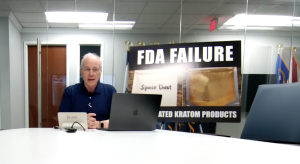- Slug: BC-CNS-Kratom. 1733 words.
- 4 photos, video story available (thumbnails, captions below).
By Nicole Macias Garibay
Cronkite News
PHOENIX – When the U.S. Drug Enforcement Administration first intended to categorize kratom, an herbal substance, as a “drug of concern” back in 2016, it was met with resistance causing it to withdraw that designation. Ever since, there has been an ongoing discussion about how kratom helps or harms people.
The public, doctors, and experts are all part of this debate. Former user Aaron, who lives in Scottsdale, reflects on his experience consuming kratom: how the substance was both helpful and harmful to him.
Photography, skating and walking his dog in the suburbs of Scottsdale are some of Aaron’s favorite hobbies. He said that these are more natural and healthy ways to deal with the stresses of life and “the challenges of reality” that come from having an addiction and mental health issues.
After struggling with alcoholism for two years, Aaron thought that trying out kratom as an alternative to drinking – as suggested by the ad he saw on Instagram – seemed like a good idea. Out of concern for his privacy, Cronkite News is not using Aaron’s last name.
“When I tried kratom, it was like it boosted my mood. It made me feel happier and it also took away some internal pain,” Aaron said. “The reason why I wanted to escape reality is because, if you are in addiction, for years on end, you hurt a lot of people, you make a lot of mistakes, you do things you wish you never did.”
Originating from a tree native to Southeast Asia, kratom has varying uses in socioreligious ceremonies, and for medical purposes to combat fatigue, increase energy and treat drug dependency, according to a 2015 article by BioMed Research International.
Kratom products include powders, pills, leaves and extracts.
Despite its concerns, the DEA has not placed kratom or its chemical components on the list of controlled substances, so it can be bought – online and in smoke shops – in some states around the country, but most have age restrictions. Arizona limits sales to people over 18 and prohibits the sale of kratom that is altered with a “nonkratom substance” that could injure the consumer. The state also requires labels for products that contain kratom, even when they are sold as a food or dietary supplement.
Aaron’s journey consuming kratom
Aaron, 22, bought his first bottle of “feel free,” a liquid product labeled as an herbal supplement containing kratom, in a smoke shop last October.
He described having a better mood, feeling uplifted and more social after taking the recommended dosage of 3.5 grams of kratom per day.
After a week, Aaron noticed that he was developing a “mental obsession” of having to use kratom to feel normal. This led him to keep increasing his daily dosage, he said.
“I was taking kratom as much as I was drinking,” Aaron said. “I picked up right where I left off.”
After three months of consuming 21 grams per day of kratom, or sometimes up to 40 grams, Aaron experienced negative side effects.
He said he would wake up in the morning determined to stop consuming kratom that day, and then feel anxious, uneasy, fatigued and depressed.
Some physical effects Aaron reported included nausea and vomiting. According to the DEA, users can also experience itching, sweating, dry mouth, constipation, increased urination, rapid heart beat, drowsiness and loss of appetite.
Because of its two main chemical components, mitragynine and 7-hydroxymitragynine, kratom has opioid-like behavioral and addictive effects on users, according to the October article in the journal Molecules.
Its effects are dose-dependent. While small doses resemble the stimulatory effects of drugs such as cocaine or amphetamines, larger doses resemble sedative-narcotic effects of opiates, according to a 2015 scientific article in BioMed Research International.
It is difficult to determine a safe dose of kratom since there does not appear to be enough research to determine how much it takes to cause an overdose. While they rarely happen, there are unintentional overdose deaths related to kratom, according to the Centers for Disease Control and Prevention.
Between July 2016 and December 2017, the State Unintentional Drug Overdose Reporting System counted almost 27,400 overdose deaths in 27 states. Of those, 152 tested positive for kratom by a medical examiner; in 91, kratom was determined to be the cause of death and kratom tested as the only substance taken in just seven of those cases.
Legal status of kratom
In 2016, the DEA announced its plans to classify kratom as a Schedule 1 controlled substance, determining that it has no accepted medical use and it has a high potential for abuse.
One year later, the federal Department of Health and Human Services released a letter supporting the ban. The actions were met with resistance from advocate organizations, lawmakers and the public.
“These arguments made about the safety of kratom need to be examined more closely,” said Mac Haddow, a senior fellow on public policy at the American Kratom Association. “They need to be subjected to more rigorous science and just accepting what a medical examiner says is not, unfortunately, giving an accurate report to the families that are involved in these things.”
The American Kratom Association, which says it represents 3 million kratom U.S. consumers, released a statement asking for remedial action on the 2017 Food and Drug Administration’s public health advisory on Kratom.
Haddow said that the FDA classification of kratom as a substance with no medical purposes is “unjustifiable” as the latest assessment showed that people use it to self-treat chronic pain, psychiatric disorders and withdrawal symptoms.
More than 130,000 people signed a White House petition in 2016 opposing the kratom ban and a bipartisan group of 51 members of Congress – including Arizona Rep. Paul Gosar and then-Rep. Matt Salmon, both Republicans – sent a letter that year to the DEA pleading to delay the process and take into account public and researchers’ opinions.
As of now, the FDA has not approved kratom for any medical use or as a dietary supplement; its state regulations vary, but research initiatives for its consumption continue.
Dr. Michelle Ruha, chair of the Department of Medical Toxicology at Banner – University Medical Center in Phoenix, said she doesn’t want to discredit the benefits of kratom, but she sees more medical problems associated with it.
“It’s not regulated so when you buy a bottle of kratom in whatever form, you have no idea what you are getting,” Ruha said. “You don’t know if it’s kratom. You don’t know the purity, the potency, you don’t know if there’s contaminants … Regarding potency, there may be no kratom or there may be actually way more than anything you would find naturally.”
Positives of kratom
There are at least 1.9 million people in the U.S. reportedly using kratom to mitigate symptoms of pain, anxiety, depression and opioid withdrawal, according to the National Institute on Drug Abuse.
Janiece Rice, a former kratom user based in Mesa, reported taking it for pain relief.
As an accountant and owner of YAME (Your Accounting Made Easy) Consulting, she spent most of the day sitting at a desk in front of a computer screen that led to shoulder pain and headaches. Her doctor prescribed Vicodin – a narcotic used to treat pain that contains acetaminophen and hydrocodone.
Because of the side effects from Vicodin, among them nausea, vomiting, constipation and dizziness, she did an online search for a natural substance that relieves pain and found kratom.
For Rice, kratom replaced other medications – Topamax, birth control, Ambien, ibuprofen and many more – that treated her migraines, menstrual cramps, depression and tendinitis.
“To me, it’s really no different (than other pain medications), as long as you’re taking two and not every day,” Rice said. “ It’s no different than taking some Tylenol. Tylenol is just as bad on your liver than anything else is.”
Because Rice was taking an average of eight pills every day, kratom started to cause liver problems, and she decided to stop taking it.
Rice said that the growing popularity of kratom is making it more accessible for younger people, but she cautions that it is very addictive when taken in high doses.
Aaron’s resources to recovery
After telling his mom about his addiction, losing his job and dropping out of college, Aaron decided to get help to combat his abuse to kratom. With the continued support of his family, he checked himself into detox at Calvary Healing Center
“Recovery is definitely the best thing that I ever started doing in my life. Being sober,” Aaron said. “I have bad days. I have good days. But my worst day sober is better than my best day using. It’s night and day of how my life is now and how it was in the past.”
Aaron goes to Alcoholics Anonymous meetings to be reminded of his addiction and continue the 12-step program, a peer-based plan that helps people overcome addiction, avoid triggers and live a healthy life.
In his room, Aaron keeps a sheet of paper pinned to a board that reads “What/Who I was before drugs/alcohol.” Reliable, carefree, excited, confident, fun and energetic are some of the words he used to describe himself.
Aaron said he makes an effort and a decision every day to not fall back into addiction. He’s taking back ownership of his life and he’s excited for what’s in store for the future, including his plan to enroll in college next semester.
^__=



